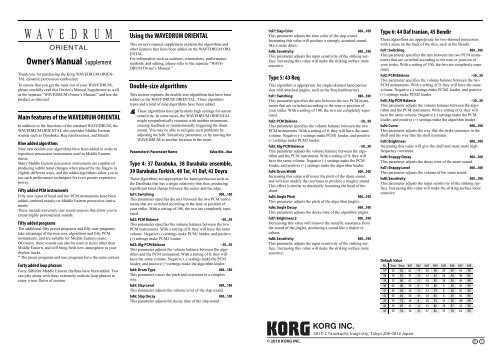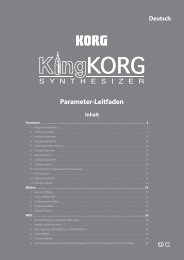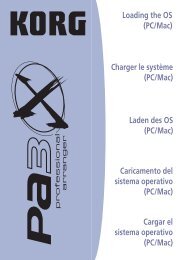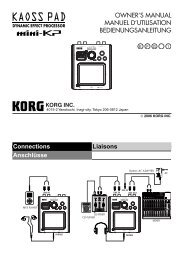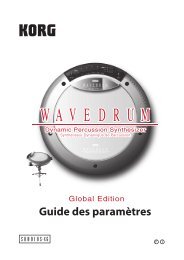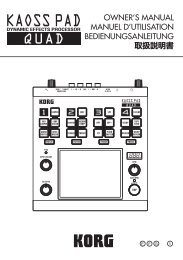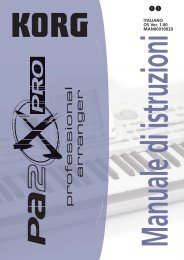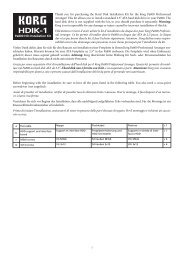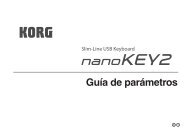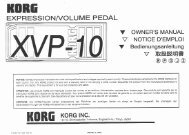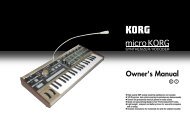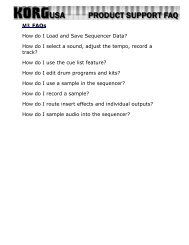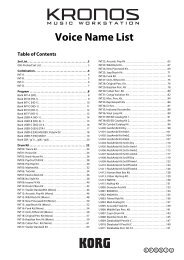WAVEDRUM_ORT_OM_E1.pdf - Korg
WAVEDRUM_ORT_OM_E1.pdf - Korg
WAVEDRUM_ORT_OM_E1.pdf - Korg
You also want an ePaper? Increase the reach of your titles
YUMPU automatically turns print PDFs into web optimized ePapers that Google loves.
Owner’s Manual Supplement<br />
Thank you for purchasing the <strong>Korg</strong> <strong>WAVEDRUM</strong> ORIEN-<br />
TAL dynamic percussion synthesizer.<br />
To ensure that you get the most out of your <strong>WAVEDRUM</strong>,<br />
please carefully read this Owner’s Manual Supplement as well<br />
as the separate “<strong>WAVEDRUM</strong> Owner’s Manual,” and use the<br />
product as directed.<br />
Main features of the <strong>WAVEDRUM</strong> ORIENTAL<br />
In addition to the functions of the standard <strong>WAVEDRUM</strong>, the<br />
<strong>WAVEDRUM</strong> ORIENTAL also provides Middle Eastern<br />
sounds such as Darabuka, Req (tambourine), and Bendir.<br />
Nine added algorithms<br />
Nine new double-size algorithms have been added in order to<br />
reproduce percussion instruments used in Middle Eastern<br />
music.<br />
Many Middle Eastern percussion instruments are capable of<br />
producing subtle tonal changes when played by the fingers in<br />
slightly different ways, and the added algorithms allow you to<br />
use such performance techniques for even greater expressive<br />
power.<br />
Fifty added PCM instruments<br />
Fifty new types of head and rim PCM instruments have been<br />
added, centered mainly on Middle Eastern percussion instruments.<br />
These include extremely rare sound sources that allow you to<br />
create highly personalized sounds.<br />
Fifty added programs<br />
The additional fifty preset programs and fifty user programs<br />
take advantage of the nine new algorithms and fifty PCM<br />
instruments, and are suitable for Middle Eastern music.<br />
Of course, these sounds can also be used in styles other than<br />
Middle Eastern, and will bring fresh new atmosphere to your<br />
rhythm tracks.<br />
* The preset programs and user programs have the same content.<br />
Forty added loop phrases<br />
Forty different Middle Eastern rhythms have been added. You<br />
can play along with these extremely realistic loop phrases to<br />
enjoy a new flavor of session.<br />
Using the <strong>WAVEDRUM</strong> ORIENTAL<br />
This owner's manual supplement explains the algorithms and<br />
other features that have been added on the <strong>WAVEDRUM</strong> ORI-<br />
ENTAL.<br />
For information such as cautions, connections, performance<br />
methods, and editing, please refer to the separate “WAVE-<br />
DRUM Owner’s Manual.”<br />
Double-size algorithms<br />
This section explains the double-size algorithms that have been<br />
added on the <strong>WAVEDRUM</strong> ORIENTAL. Three algorithm<br />
types and a total of nine algorithms have been added.<br />
These algorithms have particularly high settings for sensor<br />
sensitivity. In some cases, the <strong>WAVEDRUM</strong> ORIENTAL<br />
might sympathetically resonate with another instrument,<br />
causing feedback or unintentionally triggering the drum<br />
sound. You may be able to mitigate such problems by<br />
adjusting the hd8: Sensitivity parameter, or by moving the<br />
<strong>WAVEDRUM</strong> to another location in the room.<br />
Parameter#: Parameter Name Value Min...Max<br />
Type 4: 37 Darabuka, 38 Darabuka ensemble,<br />
39 Darabuka Turkish, 40 Tar, 41 Daf, 42 Doyra<br />
These algorithms are appropriate for hand percussion such as<br />
the Darabuka that has a single relatively thin skin, producing<br />
significant tonal change between the center and the edge.<br />
hd1: Switching 000...100<br />
This parameter specifies the mix between the two PCM instruments<br />
that are switched according to the tone or position of<br />
your strike. With a setting of 100, the two are completely separated.<br />
hd2: PCM Balance –50...50<br />
This parameter specifies the volume balance between the two<br />
PCM instruments. With a setting of 0, they will have the same<br />
volume. Negative (-) settings make PCM1 louder, and positive<br />
(+) settings make PCM2 louder.<br />
hd3: Alg-PCM Balance –50...50<br />
This parameter adjusts the volume balance between the algorithm<br />
and the PCM instrument. With a setting of 0, they will<br />
have the same volume. Negative (-) settings make the PCM<br />
louder, and positive (+) settings make the algorithm louder.<br />
hd4: Drum Type 000...100<br />
This parameter varies the pitch and overtones in a complex<br />
way.<br />
hd5: Slap Level 000...100<br />
This parameter adjusts the volume level of the slap sound.<br />
hd6: Slap Decay 000...100<br />
This parameter adjusts the decay time of the slap sound.<br />
hd7: Slap Color 000...100<br />
This parameter adjusts the tone color of the slap sound.<br />
Increasing this value will produce a strongly accented sound<br />
like a snare drum.<br />
hd8: Sensitivity 000...100<br />
This parameter adjusts the input sensitivity of the striking surface.<br />
Increasing this value will make the striking surface more<br />
sensitive.<br />
Type 5: 43 Req<br />
This algorithm is appropriate for single-skinned hand percussion<br />
with attached jingles, such as the Req (tambourine).<br />
hd1: Switching 000...100<br />
This parameter specifies the mix between the two PCM instruments<br />
that are switched according to the tone or position of<br />
your strike. With a setting of 100, the two are completely separated.<br />
hd2: PCM Balance –50...50<br />
This parameter specifies the volume balance between the two<br />
PCM instruments. With a setting of 0, they will have the same<br />
volume. Negative (-) settings make PCM1 louder, and positive<br />
(+) settings make PCM2 louder.<br />
hd3: Alg-PCM Balance –50...50<br />
This parameter adjusts the volume balance between the algorithm<br />
and the PCM instrument. With a setting of 0, they will<br />
have the same volume. Negative (-) settings make the PCM<br />
louder, and positive (+) settings make the algorithm louder.<br />
hd4: Drum Width 000...100<br />
Increasing this value will lower the pitch of the drum sound,<br />
and will also modify the overtones to produce a rougher sound.<br />
This effect is similar to drastically loosening the head of the<br />
drum.<br />
hd5: Jingle Pitch 000...100<br />
This parameter adjusts the pitch of the algorithm jingles.<br />
hd6: Jingle Decay 000...100<br />
This parameter adjusts the decay time of the algorithm jingles.<br />
hd7: Brightness 2 000...100<br />
Decreasing this value will remove the metallic resonance from<br />
the sound of the jingles, producing a sound like a shaker or<br />
cabasa.<br />
hd8: Sensitivity 000...100<br />
This parameter adjusts the input sensitivity of the striking surface.<br />
Increasing this value will make the striking surface more<br />
sensitive.<br />
4015-2 Yanokuchi, Inagi-city, Tokyo 206-0812 Japan<br />
Type 6: 44 Daf Iranian, 45 Bendir<br />
These algorithms are appropriate for two-skinned percussion<br />
with a snare on the back of the skin, such as the Bendir.<br />
hd1: Switching 000...100<br />
This parameter specifies the mix between the two PCM instruments<br />
that are switched according to the tone or position of<br />
your strike. With a setting of 100, the two are completely separated.<br />
hd2: PCM Balance –50...50<br />
This parameter specifies the volume balance between the two<br />
PCM instruments. With a setting of 0, they will have the same<br />
volume. Negative (-) settings make PCM1 louder, and positive<br />
(+) settings make PCM2 louder.<br />
hd3: Alg-PCM Balance –50...50<br />
This parameter adjusts the volume balance between the algorithm<br />
and the PCM instrument. With a setting of 0, they will<br />
have the same volume. Negative (-) settings make the PCM<br />
louder, and positive (+) settings make the algorithm louder.<br />
hd4: Curve 000...100<br />
This parameter adjusts the way that the strike resonates in the<br />
shell and the way that the shell resonates.<br />
hd5: Brightness 000...100<br />
Increasing this value will give the shell and snare more highfrequency<br />
overtones.<br />
hd6: Snappy Decay 000...100<br />
This parameter adjusts the decay time of the snare sound.<br />
hd7: Snappy Level 000...100<br />
This parameter adjusts the volume of the snare sound.<br />
hd8: Sensitivity 000...100<br />
This parameter adjusts the input sensitivity of the striking surface.<br />
Increasing this value will make the striking surface more<br />
sensitive.<br />
Default Value<br />
No. Tune Decay hd1 hd2 hd3 hd4 hd5 hd6 hd7 hd8<br />
37 50 82 62 -4 -20 90 28 39 44 90<br />
38 50 83 45 -11 -24 63 28 50 48 82<br />
39 53 86 62 -3 -18 85 28 50 48 90<br />
40 60 88 40 0 -18 86 8 50 50 90<br />
41 40 84 40 -5 -32 79 8 50 50 90<br />
42 50 86 40 -8 -26 83 8 50 50 90<br />
43 59 74 36 0 -28 34 35 50 100 90<br />
44 30 85 42 -4 -34 86 28 87 42 90<br />
45 50 54 34 -8 -37 82 33 78 63 90<br />
© 2010 KORG INC. E 1
<strong>WAVEDRUM</strong> ORIENTAL Specifications<br />
Dynamic Percussion Synthesizer<br />
Algorithms: Single-size 26, Double-size 19<br />
PCM instruments: Head 150, Rim 150<br />
Programs: 300 (User 150, Preset 150)<br />
Loop phrase: 140<br />
Effect: Reverb, Delay<br />
Controls: VOLUME knob, WRITE button, Buttons 1– 4,<br />
BANK/MODE button, VALUE knob<br />
Input/Output jacks: Output L, R (Monaural phone jack), Phones<br />
(Stereo mini phone jack), AUX IN (Stereo mini phone jack)<br />
Display: 3-character 7-segment LED<br />
Sampling frequency: 48 kHz<br />
A/D, D/A conversion: 24 bit<br />
Power supply: DC9V 1.7A<br />
Dimensions (WxDxH): 344×349×75 mm /<br />
13.54"x13.74"x2.95"<br />
Weight: 2.0 kg / 4.41 lbs.<br />
Included items: AC Adapter, Tuning key, Allen wrench,<br />
<strong>WAVEDRUM</strong> ORIENTAL Owner’s Manual Supplement,<br />
<strong>WAVEDRUM</strong> Owner’s Manual, <strong>WAVEDRUM</strong> Voice Name List<br />
Options: Percussion Stand ST-WD<br />
* Specifications and appearance are subject to change without<br />
notice for improvement.<br />
Comparison of the <strong>WAVEDRUM</strong> ORIENTAL and the <strong>WAVEDRUM</strong><br />
The following table shows the ways in which the sounds of the<br />
<strong>WAVEDRUM</strong> ORIENTAL differ from the sounds of the standard<br />
<strong>WAVEDRUM</strong>.<br />
<strong>WAVEDRUM</strong> ORIENTAL <strong>WAVEDRUM</strong><br />
Programs*<br />
Double-size<br />
algorithms<br />
PCM<br />
instruments<br />
150 user:<br />
000–149 ( 000–149)<br />
150 preset:<br />
000–149 ( P . 00– Q .49)<br />
19 10<br />
150 head<br />
150 rim<br />
Loop phrases 140 100<br />
100 user:<br />
000–99 ( 00– 99)<br />
100 preset:<br />
000–99 ( P00– p99)<br />
100 head<br />
100 rim<br />
* <strong>WAVEDRUM</strong> ORIENTAL programs 000–099 (user 000–<br />
099 and preset P. 00– P . 99) are the same as those of the<br />
<strong>WAVEDRUM</strong>.<br />
Programs 100–149 (user 100–149 and preset q . 00– q .49) are<br />
unique to the <strong>WAVEDRUM</strong> ORIENTAL.<br />
Corrections to the <strong>WAVEDRUM</strong> Owner’s<br />
Manual and Voice Name List<br />
Due to the algorithms and programs that have been added on<br />
the <strong>WAVEDRUM</strong> ORIENTAL, please make the following corrections<br />
to the included “<strong>WAVEDRUM</strong> Owner’s Manual” and<br />
“<strong>WAVEDRUM</strong> Voice Name List.”<br />
<strong>WAVEDRUM</strong> Owner’s Manual<br />
Page 4 left column, lines 19 and 25;<br />
page 9 right column, line 41<br />
36 different algorithms ..., 36 different ...<br />
→ 45 different algorithms ..., 45 different ...<br />
Page 4 left column, line 30<br />
200 different PCM instruments for head and rim<br />
→ 300 different PCM instruments for head and rim<br />
Page 4 right column, lines 1, 2 and 6<br />
100 preset programs, 100 User programs, 100 ...<br />
→ 150 preset programs, 150 User programs, 150 ...<br />
Page 4 right column, lines 11 and 12<br />
100 loop phrases<br />
→ 140 loop phrases<br />
Page 7 left column, lines 31; right column, lines 7 and 15;<br />
page 9 left column, line 18<br />
00– 99, P00– P99<br />
→ 000–149, P . 00– P . 99– q . 00– q .49<br />
Page 12, 5. Algorithm Select (ALG)<br />
hd. A 01 ... 36<br />
→ hd. A 01 ... 45<br />
27... 36 : Double-size algorithms<br />
→ 27...45 : Double-size algorithms<br />
hd. P 001 ...100<br />
→ hd. P 001 ...150<br />
r . P 001 ...100<br />
→ r . P 001 ...150<br />
Page 15, 1. Common (Co )<br />
LoP 001 ...100<br />
→ LoP 001 ...140<br />
(Default Value: 1)<br />
→ (Default Value: 117)<br />
Page 26 left column, line 2<br />
Double-sized algorithms are organized into three types, ...<br />
→ Double-sized algorithms are organized into six types, ...<br />
Page 27<br />
The <strong>WAVEDRUM</strong> ORIENTAL adds nine algorithms. Refer<br />
to “Double-size algorithms” on the preceding page.<br />
Page 30 Specifications<br />
Refer to “<strong>WAVEDRUM</strong> ORIENTAL Specifications”.<br />
<strong>WAVEDRUM</strong> Voice Name List<br />
To the “<strong>WAVEDRUM</strong> Voice Name List,” add the following<br />
“Programs,” “PCM Instruments,” “Algorithms,” and “Loop<br />
Phrases.”<br />
Replace “Live mode” with the content of the following section.<br />
Programs<br />
No. Program<br />
Head<br />
Algo. Inst.<br />
Rim<br />
Algo. Inst.<br />
Real Simulation of Middle East Instrument<br />
100 Darabuka Ensemble (Double-size) 38 - - -<br />
101 Darabuka (Double-size) 37 - - -<br />
102 Darabuka Tarkish (Double-size) 39 - - -<br />
103 Daf (Double-size) 41 - - -<br />
104 Daf Iranian (Double-size) 44 - - -<br />
105 Daf Egyptian 22 110 18 119<br />
106 Iranian Hard Daf - Lo 10 109 18 121<br />
107 Tar (Double-size) 40 - - -<br />
108 Bendir (Double-size) 45 - - -<br />
109 Dark Bendir 12 112 10 106<br />
110 Big Bendir 1 111 15 124<br />
111 Doyra (Double-size) 42 - - -<br />
112 Req (Double-size) 43 - - -<br />
113 Req-Clap Set 19 130 18 133<br />
114 Big Req 10 129 1 120<br />
115 Sagat Egyptian 18 131 8 125<br />
116 Bells and Sagat 18 132 8 128<br />
117 Tabil 12 108 2 111<br />
118 Katim 10 117 10 110<br />
119 Nakrazan 19 118 1 113<br />
120 Bongos Hi/Lo 19 114 19 136<br />
121 Zeer & Tweasat 19 115 18 129<br />
122 Zeer Pitched 19 116 18 121<br />
123 Khishbah 25 123 19 115<br />
124 Sagool Combination 22 120 5 118<br />
Creative Sound of Middle East Instrument<br />
125 Katim Gated 10 107 7 108<br />
126 Tantan-Katim 10 128 19 109<br />
127 Group Percussion 12 127 19 135<br />
128 Asma Davul Electronic 26 121 15 116<br />
129 Mix Doholla-Drum 26 106 22 104<br />
130 Daf Pitched 7 119 10 105<br />
131 Ceramic Mini Dbk 1 101 1 124<br />
132 Egyptian String 13 135 13 132<br />
133 Egyptian Playground 13 126 19 112<br />
Real Simulation of Non Middle East Instrument<br />
134 Ghatam 1 125 1 117<br />
135 Shekele 22 136 18 137<br />
Synthy Simulation of Middle East Instrument<br />
136 Voice Percussion 25 148 18 150<br />
137 White Blocks 22 143 22 130<br />
138 Minimal Logs 23 137 17 131<br />
139 Tar Drum Kit 12 146 19 107<br />
140 Unhappy Camels 14 124 10 127<br />
141 Suspicious Eyes 19 122 18 122<br />
142 Darabuka Roll 10 104 7 102<br />
143 World DnB K/H/S 6 134 19 122<br />
144 The Price of Oil 10 113 5 114<br />
SFX<br />
145 Breath in the Amber 4 141 2 141<br />
146 Wind Chimes 23 144 18 140<br />
147 Bottle Synth 5 142 1 142<br />
148 Rain Stick 18 140 18 134<br />
149 Boarder Crossing 10 105 21 123<br />
Voice Name List<br />
PCM Instruments<br />
No.<br />
Head PCM<br />
Instrument<br />
Rim PCM<br />
Instrument<br />
101 Tiny Darabuka Darabuka Bend<br />
102 Darabuka Bend Egybt Drb Grace Edge<br />
103 Darabuka Grace Hit Darabuka Grace Hit<br />
104 Egypt Drb Roll Center Doholla Edge<br />
105 Darabuka Tek to Vox Kick Daf Tek Mute<br />
106 Doholla Center Bendir Tek Mute<br />
107 Katim Center Tar Tek Mute<br />
108 Tabil Open Katim Edge<br />
109 Daf 21" Hard Bak Katim Tak<br />
110 Daf Tek Egypt Katim Mute<br />
111 Big Bendir 14" Tabil Rim<br />
112 Bendir Dum World DnB 2B<br />
113 Low Pitch ADDum 3VS Nakrazan Mute<br />
114 Bongos Low Tricky Tek Mix 6VS<br />
115 Zeer Kasur Rim<br />
116 Zeer Pitch Head Asma Davul Tek Rim<br />
117 Katim Yahal Tek<br />
118 Nakrazan Sagool Rim<br />
119 Tar Snip TD Jingle<br />
120 Sagool Head Req Edge<br />
121 Asma Davul Head Req - Tik<br />
122 Gulf Jam Set 3VS World DnB 1B<br />
123 Khishbah Ragaf Riqq to Vox Snare<br />
124 Wacky 3VS Khishbah Lo Pitch Req Open<br />
125 Yahal Dum Sagat Egypt Open<br />
126 World DnB 2A Sagat Dynamic Head<br />
127 Group Drums Sagat Silver Cl→Opn 5VS<br />
128 Tantan Sagat Roll<br />
129 Req Center Tweasat<br />
130 Req Egypt Splash Jingle<br />
131 Sagat Egypt Snake Drum<br />
132 Sagat Bells Ghost Note<br />
133 Sagat Dynamic Head Clap<br />
134 World DnB 1A Rain Stick 2<br />
135 Ghost Note Chacha OpenSlap<br />
136 Rattle Maracas Bongos High Open<br />
137 Caxixi Off Beat Caxixi 2<br />
138 Angklung Angklung<br />
139 Steel Drum 2 Steel Drum 2<br />
140 Rain Stick 1 Wind Chime<br />
141 Heart Beat Breath Whistle<br />
142 Synth Perc Synth Perc<br />
143 Noise Scale Guitar Chord<br />
144 Bell Tree Tom Mid<br />
145 SD-HH Hi Toms Pitch<br />
146 Two Brushed Toms Stick Cymbal<br />
147 Tom Mid SD-HH<br />
148 Tuunn SFX<br />
149 Hey! Zil Hey! Zil<br />
150 SFX Uuh<br />
Live mode<br />
Button<br />
Program<br />
Bank-a<br />
1 100 Darabuka Ensemble (Double-size)<br />
2 103 Daf (Double-size)<br />
3 123 Khishbah<br />
4 108 Bendir (Double-size)<br />
Bank-b<br />
1 101 Darabuka (Double-size)<br />
2 104 Daf Iranian (Double-size)<br />
3 113 Req-Clap Set<br />
4 122 Zeer Pitched<br />
Bank-c<br />
1 132 Egyptian String<br />
2 140 Unhappy Camels<br />
3 139 Tar Drum Kit<br />
4 149 Boarder Crossing<br />
Algorithms<br />
No. Algorithm<br />
37 Darabuka (Double-size)<br />
38 Darabuka ensemble (Double-size)<br />
39 Darabuka Turkish (Double-size)<br />
40 Tar (Double-size)<br />
41 Daf (Double-size)<br />
42 Doyra (Double-size)<br />
43 Req (Double-size)<br />
44 Daf Iranian (Double-size)<br />
45 Bendir (Double-size)<br />
Loop Phrases<br />
No. Loop Phrase [bpm] No. Loop Phrase [bpm]<br />
101 7/8 [96] 121 Maksoum Sarih [160]<br />
102 Arabic Rumba [96] 122 Mallaya [220]<br />
103 Ayoub [94] 123 Masmoudi [126]<br />
104 Baladi 1 [112] 124 Nobi [95]<br />
105 Baladi 2 [130] 125 Rumba [138]<br />
106 Baladi 3 [130] 126 Saidi 1 [109]<br />
107 Benderi [174] 127 Saidi 2 [120]<br />
108 Eskandarani [140] 128 Saidi 3 [120]<br />
109 Fallahi [220] 129 Saidi 4 [120 ]<br />
110 Gorgina 10/8 [170] 130 Saidi 5 [120 ]<br />
111 Hajaa Soudasi 6/8 [124] 131 Saidi 6 [120]<br />
112 Karatchi [110] 132 Saidi 7 [120]<br />
113 Katakofti 1 [113] 133 Saidi Modern [130]<br />
114 Katakofti 2 [110] 134 Samai [120]<br />
115 Katakofti Modern [113] 135 Shabi [160]<br />
116 Khbeti 6/8 [152] 136 Soudasi 6/8 [122]<br />
117 Laf 1 [112] 137 Wehda 1 [120]<br />
118 Laf 2 [110] 138 Wehda 2 [120]<br />
119 Maksoum 1 [127] 139 Wehda 3 [120]<br />
120 Maksoum 2 [130] 140 Zaffa [96]


